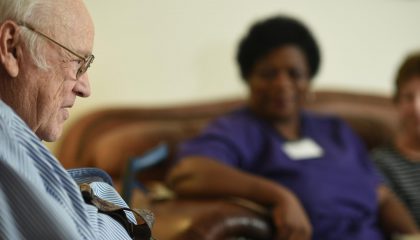CONTACT US Call (919) 655-5068 OR Inquire Online >>


Our primary goal is to bring "Peace of Mind" when answering your senior in home care concerns.
(336) 338-7700
Email: info103@wisdomseniorcare.com
Wisdom Senior Care
1931 New Garden Road Suite 204 Greensboro, NC 27410
CONTACT US Call (919) 655-5068 OR Inquire Online >>

Arthritis is a medical condition many seniors struggle with. World Arthritis Day takes place on October 12th. This month, learn more about this type of disease. Did you know that arthritis is the leading cause of disability in the United States? Many seniors struggle with this type of disease. Over 54 million adults in the US have been diagnosed with a form of arthritis. Since the condition is common among seniors, it is important to understand the symptoms and effects of arthritis when caring for them.
A word used to describe joint pain and joint disease, arthritis comes in many forms. Some of the most common types of arthritis include osteoarthritis and rheumatoid arthritis. Seniors often develop osteoarthritis.
This form of arthritis occurs when the cartilage breaks down. Cartilage is the tissue that covers the ends of bones at joints. Cartilage is found largely in joints like the knees, hips, and shoulders. When the cartilage breaks down, the bones can rub against each other, wearing away at the bones, reducing mobility, and causing both stiffness and pain.
Typically, osteoarthritis occurs in older adults. It tends to occur as a part of aging since the cartilage is worn down over time and with extensive use.
Although osteoarthritis is caused by wear and tear, it is preventable to a point. Adults should take care to stretch and to use their joints safely by bending to lift properly. This may reduce or delay osteoarthritis if a person is prone to the condition.
Unfortunately, osteoarthritis cannot be completely cured or reversed. However, there are ways to reduce the pain and difficulties that result from the condition.
 Read more +
August 22, 2015 By Kobiye Batchassi in CAREGIVERS, IN HOME CARE
Read more +
August 22, 2015 By Kobiye Batchassi in CAREGIVERS, IN HOME CARE
 Read more +
August 21, 2015 By Kobiye Batchassi in CAREGIVERS, IN HOME CARE
Read more +
August 21, 2015 By Kobiye Batchassi in CAREGIVERS, IN HOME CARE
 Read more +
August 7, 2015 By Kobiye Batchassi in CAREGIVERS, IN HOME CARE
Read more +
August 7, 2015 By Kobiye Batchassi in CAREGIVERS, IN HOME CARE
 Read more +
By Kobiye Batchassi in CAREGIVERS, IN HOME CARE
Read more +
By Kobiye Batchassi in CAREGIVERS, IN HOME CARE